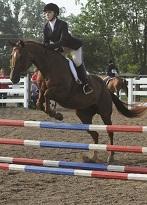
 |
| A horse and rider compete in the eventing cross country test in the World Equestrian Games in Aachen, Germany. Photo by Bob Langrish. |
Demands for historic Greenwich Park, well-known site of the 2012 Olympic dressage, eventing and jumping competitions were intense: space to accommodate the design of a 5.7-kilometer cross-country course, featuring 42 jumps with water obstacles, slopes and hills, as well as the main equestrian arena, training area and stables. In addition, there was the all-important arena footing (sand and fiber mix with a binder was chosen, similar to the 2008 Olympic stadium and other international shows), which of course needed final approval from the International Equestrian Federation (Fédération Equestre Internationale or FEI). Finally, seating needed to accommodate 23,000 spectators. Additional challenges included the need to wow an international viewing audience, minimize security concerns and have the ability to reinstate the park upon conclusion of the Olympic games – requiring this be constructed as a temporary facility.
Few events are under as extreme scrutiny, but the goal is the same: athletes and spectators should leave with a safe, positive experience.
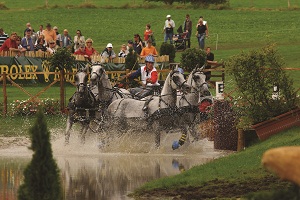 |
| Driving competition at the World Equestrian Games in Aachen, Germany. Photo by Bob Langrish. |
Equestrian
As most equestrians know, the sport is regulated and promoted by a variety of organizations, but governed and licensed in the United States by FEI and the United States Equestrian Federation (USEF). While FEI is the sole controlling authority for international events in dressage, jumping, eventing, driving, endurance, vaulting, reining and para-equestrian, USEF, the national governing body, chooses and trains the US Equestrian Team and licenses events at all levels—youth through Olympian—including Western styles, dressage, eventing, jumping and many other disciplines and breed-based competitions.
Kathy Meyer, senior vice president of marketing and communications for USEF, has seen several notable trends in site selection for equine events. In particular, event owners will choose venues that are likely to reduce the risk of an equine athlete sustaining an injury.
“Footing in the arenas is probably the most important and paramount thing,” says Meyer. “And I would say that the tolerance for bad footing in the last 10 or 15 years has gone to zero. You used to be able to haul into a fairgrounds, and you’d walk through the parking lot, and that may or may not have been prepared properly for a high-performance equine athlete. Facilities that are designed especially for equestrian are becoming more popular.”
She also notes the rise of circuits that allow people to congregate in a particular geographic area, such as Wellington, Florida, or Charleston, South Carolina, for weeks at a time to show their horses. “Charleston has a nice boutique hunter jumper circuit,” says Meyer. “An Arabian horse group grew a whole international migration to Scottsdale in the last couple of decades.” It is no accident that these circuits often form in geographic areas with inviting weather. “Climate and proximity drive a certain amount of that—it becomes part of the selection process,” says Meyer.
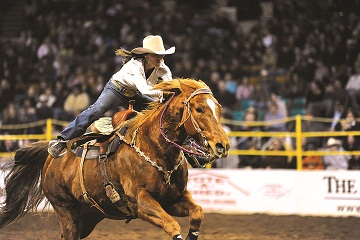 |
| Photo by Siri Stevens, Rodeo News. |
Rodeo
In North America, the largest sanctioning body for rodeo is the Professional Rodeo Cowboys Association (PRCA), the oldest such organization in the world. Each year, the PRCA sanctions about 600 multiple-event rodeos in North America. PRCA sanctions events in the following disciplines: bareback riding, steer wrestling, team roping, saddle bronc riding, tie-down roping, bull riding, and all-around.
Also worth nothing is the Professional Bull Riders (PBR), an organization dedicated to bull riding only (to the exclusion of other rodeo sports). PBR has competing cowboys from the United States, Australia, Brazil, Canada and Mexico.
Where worlds coexist
On the surface, Western rodeo and English-style equine sports might be seen as two worlds with little in common. But in horse parks around the nation, dressage exists alongside barrel racing, and hunter jumper alongside cutting.
 |
| The Professional Armed Forces Rodeo Association World Finals in Midland, Texas. Photo by Eva Scofield and BQ Gauck Photography. |
Midland, Texas
The West has strong equestrian and rodeo traditions stemming from the working horses on the ranches that have characterized so much of this region. Midland, Texas, is no exception. It sits between Fort Worth and Lubbock, with good air access. In Midland, sports tourism is big business.
“Sports in Midland is our largest market, with about $18 million in direct visitor spending that we see throughout the year,” says Katie Sangl, sports sales manager for the Midland Convention & Visitors Bureau. Equestrian and rodeo events are a core piece of this tourism. “This year for the first time we hosted the Professional Armed Forces Rodeo Association. It was a great event,” says Sangl. Other recent events have included Tex-Mex Barrel Racing, a quarter horse association stock show, and Ultimate Calf Roping from junior to adult. Midland also has an ongoing polo club.
Midland’s premier equestrian facility is the Midland County Horseshoe. The arena, now seven years old, was built to attract equestrian business, and is planning a $20 million expansion.
Lawton, Oklahoma
Lawton, Oklahoma is flanked to its north by Fort Sill and the Wichita Mountains. It is home to the Lawton Rangers Rodeo, Oklahoma’s second-largest rodeo. The city is home to two popular equestrian facilities.
“We have the Lawton Rangers LO Ranch Arena,” says Tanna Vu, tourism director for the Lawton Fort Sill Chamber of Commerce. “The seating capacity out there is 8,500. We have the Great Plains Coliseum, which seats 2,500. We have right adjacent to it the Great Plains Expo building, which has over 80,000 square feet. Those are really our biggest venues.”
The Lawton Rangers Rodeo is a PRCA rodeo that is approaching its 75th year. The rodeo coincides each year with Lawton’s birthday celebration. In the most recent rodeo, there were over 400 participants representing 29 states and Canada. Over 20,000 people attended the event over four days in August.
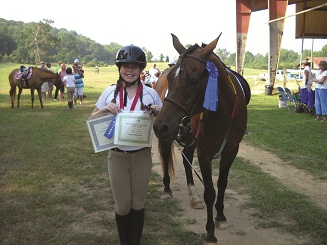 |
| 2012 EGRA Open Show. Photo courtesy of Betsy Christian. |
Rapid City, South Dakota
Many Rapid City, South Dakota, visitors are drawn in by the nearby Mt. Rushmore and Black Hills mountain range. But equestrian and rodeo events are a core attraction as well. “Those are two niches that we fulfill here in Rapid City,” says Domico Rodriguez, sports and events sales director for the Rapid City Convention & Visitors Bureau. “One of our facilities is our Central States Fairgrounds, and that is the main venue that is used year round. They host horse or rodeo events all but two or three weeks out of the year. Our Rushmore Plaza Civic Center and the Central States Fairgrounds host the Black Hills Stock Show and Rodeo, and that is huge.”
Each year, more than 300,000 people attend the Black Hills Stock Show and Rodeo, in a city with a population of about 70,000. Rapid City’s position as the largest city within roughly a five-hour drive makes it a regional attraction and a popular shopping place for visitors who are in town for equestrian and rodeo events. The Northwest Ranch Cowboy’s Association Finals Rodeo, which will be in Rapid City for the second year this November, coincides with Thanksgiving—and Black Friday. “It was a great success last year, and we hope to build on that success,” says Rodriguez.
Snohomish County, Washington
Equine and rodeo events are first and foremost about the sport, but Tammy Dunn, a sports marketer with the Snohomish County Sports Commission, has noticed that’s not the only thing that motivates people to choose to hold or to seek out events in certain geographic locations.
“With sport events, people come for the sporting events, but why else would they want to come here? The experience. Families are coming with their son and daughter and they are making a vacation,” says Dunn.
Snohomish County boasts two venues that are well equipped to handle equestrian and rodeo events. The Comcast Arena in Everett is a 10,000-seat facility that has hosted rodeos, the Professional Bull Riders touring pro division, and the Lippizaner stallions. The Evergreen State Fairgrounds has a 60,000-square-foot indoor equestrian center with seating for 2,700.
 |
| The Clinton County Fairgrounds. Photo courtesy of the Clinton County Convention & Visitors Bureau |
Clinton County, Ohio
Clinton County, Ohio, is a rural area situated in close proximity to Cincinnati, Dayton and Columbus. For equestrian sports, it is home to the Roberts Arena. Rodeos are held at the Clinton County Fairgrounds.
The Roberts Arena is equipped to house shows across equestrian disciplines, including dressage, hunter jumper, barrel racing, and others. “We have people coming from 50 states for those shows to Southwest Ohio. It is nationally known, and it is regarded as a top-notch show arena,” says Debbie Stamper, Executive Director of the Clinton County Convention & Visitors Bureau.
The venue has 514 stalls and two indoor and two outdoor arenas. The two indoor facilities are 108' x 183' and 96' x 203', both with makeup arenas. The seating capacity is 268 and 480, respectively. The outdoor arenas are both 140' x 240' and also have a makeup arena. The venue offers access to a show office for announcements during events. Visitors can also make use of 91 camper spaces and an onsite restaurant.
Lexington, Kentucky
The Bluegrass Region of Kentucky is practically synonymous with horses. It is no surprise that the most elite equine sports venue in the United States—the Kentucky Horse Park—is situated within the region in Lexington. The horse park, which celebrates its 35th anniversary next year, recently underwent a number of upgrades to accommodate the 2010 World Equestrian Games. The upgrades made a historic difference in equine sports: “It was the first time that all of the different disciplines for the World Equestrian Events could be held in one place,” says Lisa Jackson, director of marketing and public relations for the Kentucky Horse Park.
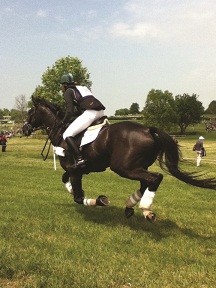 |
| Kentucky Horse Park: 2012 Rolex Event, Lexington, Kentucky. Photo courtesy of Betsy Christian. |
Each year, the Kentucky Horse Park is home to the Rolex Kentucky Three-Day Event, which in 2012 featured selection trials for the U.S. Eventing team that competed in the London Olympics. The Rolex Kentucky Three-Day Event is one of six annual Four Star events in the world. Beyond those six, the Olympic Games and World Championships are the only other existing Four Star events.
Outside of hosting international-level competitions, the park is the location of a number of smaller events each year, and offers a range of programs to provide a child’s (or an adult’s) first contact with a horse. Visitors can go on trail rides around the park. The park also offers therapeutic riding programs, including ones specifically designed for returning combat veterans.
Kentucky Horse Park is scheduled for a total of 89 events next year, a number that represents an increase over this year, and the previous year. “
Palm Beach County, Florida
Year-round warm weather has helped establish Palm Beach County, Florida, as a popular winter equestrian destination. The heart of equestrian activity in Palm Beach County is the village of Wellington, home to the Palm Beach International Equestrian Center (PBIEC). Each year, the PBIEC hosts the 12-week-long international Winter Equestrian Festival, which features elite professional-level competitions, as well as amateur events for children and adults, a vendor village and more.
Wellington is also home to the eight-field International Polo Club Palm Beach, which holds the U.S. Open Polo Championship each spring. The club has on-site amenities such as tennis courts, a spa and Sunday brunch.
Ocala, Florida
The temperate climate of Ocala in Marion County, Florida, makes it a hub for equestrian training and thoroughbred breeding, particularly in the winter when frozen ground may make training impossible in other parts of the country. “At any given time, we have more of those four-legged creatures on the ground than anywhere else in the world,” says Denise Alexander, acting director of the Ocala/Marion Visitors and Convention Bureau.
Ocala is surrounded by horse farms that are connected to thoroughbred breeding. “The number one request we get from visitors when they walk into my office,” says Alexander, “is 'Can I go on a horse farm tour?' The farms are very beautiful, very manicured. It’s a good opportunity for people who have never been exposed to the equine industry to see a foal being born. We have Gypsy Banner Horses here. We have quarter horses. We host the HITS [Horse Shows in the Sun] circuit from January to March every year….That’s an opportunity for most people that you wouldn’t have—to see that caliber of horses showing and displayed anywhere except in Ocala.”
Related Organizations
- Visit Midland
- Lawton Fort Sill Convention & Visitors Bureau
- Visit Rapid City
- Snohomish County Sports Commission
- Clinton County Convention & Visitors Bureau
- Clinton County Convention & Visitors Bureau
- Lexington Area Sports Authority
- VisitLEX
- Palm Beach County Sports Commission
- Explore Ocala Marion County

